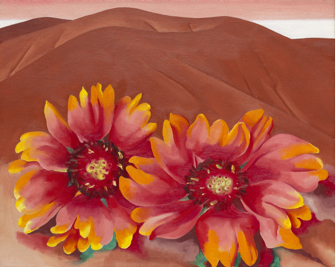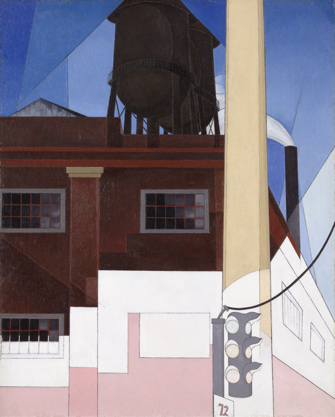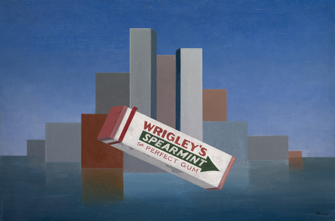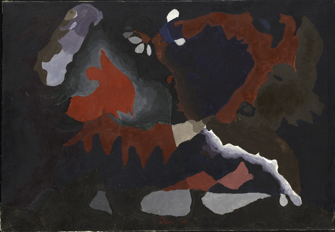
Is Grant Wood’s “American Gothic” (1930) the American “Mona Lisa”? This iconic painting is certainly just as recognizable to people around the world, although it may not have the latter’s gravitas. “American Gothic,” with its dour farm couple and their pitchfork, kicks off the exhibition “American Painting in the 1930s: The Age of Anxiety” at the Musée de l’Orangerie in Paris, which turns out to include a number of paintings by Wood, making me realize that I knew nothing else about his work (which is, I imagine, a common condition).
I was charmed by his candy-colored landscapes, which reminded me of the recent work of David Hockney, although the friend who accompanied me to the exhibition found them kitschy. With their irreal, storybook look and pillowy hills, they are pure escapism, one reaction to the hard times of the Great Depression.
Like many of the artists presented in this lively show, Wood had immersed himself in European painting before returning home to find his own, very American way. For Wood, who after “American Gothic” was identified as a Regionalist painter, home was the Midwest. The only painting of his in the show that might touch on a political theme (Wood denied that “American Gothic” was a critique of American small-town narrow-mindedness) is “The Midnight Ride of Paul Revere” (1931). In this work showing a sleeping village, an eerie light shines on the tall white church and its steeple, and on the road circling the the village, along which Paul Revere’s black horse – so small that it is hardly noticeable at first glance – gallops along. The windows of the little toy houses glow with a warm light from within.
Many of the works in the show, however, confront political themes head on. Alice Neel’s portrait of union leader Pat Whalen (1935), for example, takes a clear stance. The powerful-looking man (apparently he was rather puny in real life) sits at a table, his large, black-outlined clenched fists resting on a copy of the “Daily Worker.”
The hard life of workers is seen in the work of Joe Jones and Thomas Hart Benton, who took on the cause of the poor, oppressed and exploited. In Jones’s chilling night scene, “American Justice,” (1933) a naked black woman lies dead on the foreground, her eyes still open and a noose still hanging from the tree behind her, while a group of Ku Klux Clansmen confer in the middle ground and a house burns in the background.
Paintings by Charles Sheeler celebrate industry with depictions of factory machinery and landscapes dominated by spewing smokestacks, while Charles Demuth’s “…And the Home of the Brave” (1931), supposedly an American version of Cubism, is a rather beautiful depiction of the corner of a cigar

factory with two menacing black water towers on its roof, painted in strong shades of pink and burgundy. The sky is cut up into different shades of blue, and a pale-yellow post in the foreground contrasts with the other colors, while a gray streetlight seems to have been drained of color.
Yet another Charles, Charles Green Shaw, captured the spirit of American consumerism decades before Andy Warhol with his “Wrigley’s” (1937), showing a huge, precisely rendered pack of Wrigley’s spearmint, “the

perfect gum,” floating in front of a stylized, sky-scraping city.
Refreshingly, women and African American painters have not been completely forgotten, although they’re represented by just a few works. In addition to Neel, there are paintings by Georgia O’Keeffe, Helen Lundeberg and Doris Lee. African-American artist William H. Johnson is represented by the brightly colored, cartoon-like “Street Life, Harlem” (c. 1939), in which the two figures loom as large as the buildings behind them, and modernist Aaron Douglas, a member of the Harlem Renaissance movement, by “Aspiration” (1936), a futurist mural showing the forward movement of African Americans.
The horrendous effects of poverty are depicted in other works, such as Philip Evergood’s “Dance Marathon” (1934), which shows the 49th day of one of those danses macabres familiar to us from Sydney Pollack’s film They Shoot Horses, Don’t They? In the painting, dancers are dropping from exhaustion as they try to win prize money of $1,000 dollars and $500.
“Church Supper” by Paul Sample (1933), with festivities being held outdoors in a New England town, reminded me of village fête scenes by Brueghel, but this is Puritan America, and there is none of the dancing, drinking, fighting and sexual shenanigans seen in the Flemish master’s works.
Hints of the Abstract Expressionism that would appear after World War II pop up here and there, notably in the work of Arthur Dove.

Like Kandinsky, he tried to transpose music into images, as in “Swing Music (Louis Armstrong).” We get another peek at what was to come in an unprepossessing pre-drip abstraction painted by Jackson Pollock between 1938 and ’41.
This show offers an excellent snapshot of American art at a very particular time in the country’s history, running from the desperation and misery following the Wall Street Crash to the hope engendered by Franklin Delano Roosevelt’s Works Progress Administration (many of the artists in the show were employed by it) and the new prosperity engendered by the ramping up of the war machine.
During the 1930s, France was still the epicenter of the global art world, but the war would change all that forever as art power shifted to the brave new world of American Abstract Expressionism and France was left to its memories.
Favorite